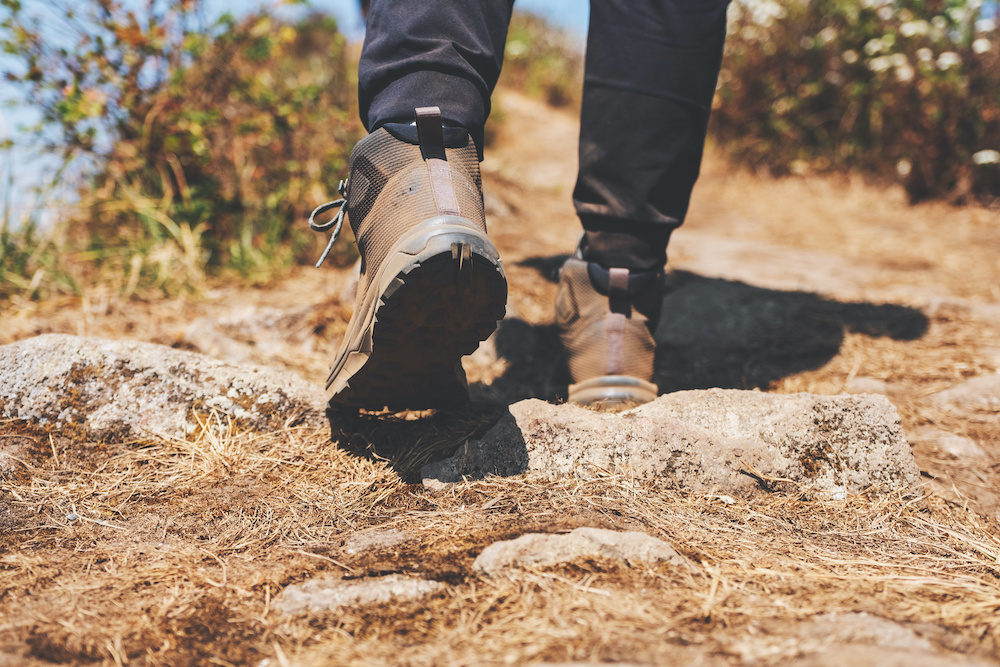
Running and hiking are great forms of exercise that will help us stay active and healthy.
Hiking is a cardio workout that offers a lot of benefits for those who love to explore nature, breathe in the fresh air, and discover new things in their surroundings.
Running, on the other hand, is a more vigorous activity that you can do anytime and anywhere if you go to a gym or have the equipment at home.
Both of these require their own set of gear, which then makes people ask: Can you run in hiking shoes? Or do you need a different pair of footwear for each one?
Hiking Versus Running
Hiking and running are both aerobic or cardiovascular activities.
This means that both activities can help boost the function of your heart and lungs while helping you to lose weight at the same time.
Hiking is a low-impact activity that you can do safely on simple terrains like parks and backcountry.
Uphill hikes are the most effective in terms of weight loss.
Running, on the other hand, is more dynamic.
It requires you to exert more energy but can be twice as much as effective as hiking.
Both activities bear the weight of your body, which is essential in lowering the risk of osteoporosis as we get older.
Between these two exercises, running seems to have a negative effect on your joints, especially those experiencing pain on their leg joints and lower back.
If you engage in either one or both activities long enough to see results, you will find that both hiking and running are both powerful exercises.
Again, these activities require you to invest in gear to protect your overall well-being, one of which is footwear.
What Are Running Shoes?
Running shoes are flexible and specifically designed to move with your feet.
They are designed with different characteristics based on each person’s varying running styles and preferences.
Since running shoes have different classifications, let us be more specific and talk about trail running shoes.
Trail running shoes, as well as hiking shoes, are both created for rough ground environments that explain the similarities in their design.
Not only are these sturdy to guard your feet against harm and injury but also lightweight to let you run at a fast pace.
The upper portion of trail running shoes uses lightweight and breathable materials.
On the other hand, the soles are made of a thick foam that has sticky lugs for better shock absorption.
They also have a tight fit on midfoot and around the heels but a full toe box for added stability and step precision.
What Are Hiking Shoes?
In contrast, hiking shoes are more focused on providing maximum protection to your feet as you venture in rougher terrain for more extended periods.
These shoes have more weight than running shoes because of the materials used in their construction.
Most hiking shoe surfaces have waterproof materials to ensure that your feet stay dry in various kinds of weather.
Soles used in hiking shoes have lesser flexibility on the forefront and offer mild traction on rough and rocky landscapes.
However, they have stickier grips and deeper lugs.
They are also designed with a stable midsole and extra cushioning to better protect your feet from rocks and tree branches along the trail.
When it comes to ankle protection and coverage, hiking shoes with higher shafts have more to offer.
They are also more substantial and more durable, dry out longer, and may need a more extended break-in period.
Can You Run in Hiking Shoes?
After taking a closer look at each shoe type, we can see that they serve different functions, though there are times when you can use one in place of the other.
For example, some light hikers would rather wear running shoes as opposed to hiking ones due to its lightness, especially if going on a long hike.
However, for backpackers, it is safer to wear hiking shoes for more ankle support and protection, as well as extra cushioning for the feet.
On the other hand, trail runners can choose to wear hiking shoes if they plan on running on rougher ground and colder weather environments.
Hiking shoes may slow down a trail runner’s pace, but they will be better protected against possible injuries
So to answer the question, yes, you can run in hiking shoes, but it is not highly recommended and only for rare occasions.
Can You Hike in Running Shoes?
What if it’s the other way around.
Can you use your running shoes to go on a hiking adventure?
Surprisingly, the answer to this question is yes, and here are some reasons why.
More and more hikers choose to wear running shoes, especially lightweight ones, when they go on long-distance hikes for comfort.
Running shoes do not require a break-in period, eliminating the chances of getting blisters even if you wear it for long periods.
That what makes it attractive for hiking enthusiasts.
Another factor considered by most hikers is the running shoes’ breathability and quick-drying aspect, which is very important while hiking.
The downside is when you bring a lot of things on a hiking trip or had foot injuries before.
If that is the case, your feet need extra protection and coverage as you explore nature while trekking those rough terrains.
Hiking Shoes Versus Hiking Boots
We always hear the words hiking shoes and hiking boots being used interchangeably, giving us the impression that they are one and the same.
These two shoe types have a lot of similarities, but they also have differences.
Hiking boots are sturdy and come with excellent ankle support, protection on rough grounds, and superior traction.
They are also your best option when hiking on rainy or snowy weather conditions since most hiking boots have waterproof features.
If you are a regular hiker traipsing up and down various terrains, hiking boots are a suitable choice for you.
Then again, there are also hiking shoes popular with casual or occasional hikers because of their comfort and resemblance to sneakers.
Trail runners are another version of hiking shoes that are more similar in design to hiking boots except for the high shaft that protects and supports the ankles.
Hiking shoes have softer materials and offer more flexibility as compared to hiking boots.
They also don’t require breaking in.
Lastly, they are constructed with breathable materials that can dry quickly when wet, so your feet stay dry during the adventure.
What About Hiking Socks?
We have been talking about shoes ever since we started this discussion, emphasizing their features as your guide so you can choose the right one for you.
You also shouldn’t forget to check on hiking socks, which are crucial parts of your overall hiking outfit, as well.
Wearing the right hiking footwear is useless if you don’t have the right socks to match your shoes.
They are the ones that touch your feet first before the shoes.
Hiking socks provide comfort and will keep your feet dry, lowering the risk of getting hotspots and blisters.
Quality hiking socks are durable enough to ensure that they can withstand the rigorous trekking they will be subjected to during the hike.
The best hiking socks are typically made of breathable wool material, which also offers excellent cushioning for superb comfort but pricier than most hiking socks.
You will find budget-friendly hiking socks that are within your limit, but they may not be as durable as the more expensive ones.
Conclusion
Can you run in hiking shoes?
This is a typical question that you will hear from those who love to wear their favorite shoes in all kinds of occasions.
As mentioned above, you can occasionally run wearing hiking shoes.
However, it is not recommended since it cannot give you the comfort that can only be achieved if you wear the right shoes for the activity.
